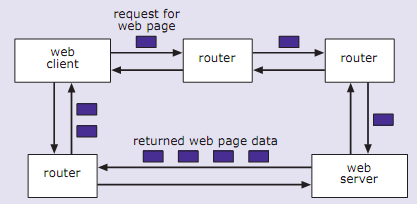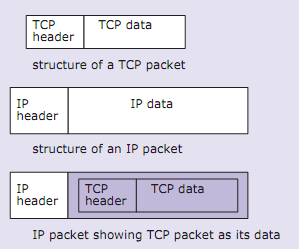Internet protocols:
We have seen that the internet developed from research in the USA in the 1960s into robust networks that could survive attack by nuclear weapons. This has had an enormous influence on the way the internet works at a technical level - its distributed structure and what are known as the communication protocols.
A protocol is a set of rules that defines the details of how computers or other devices can communicate, so that both sides can understand the communication. The part of a protocol that asks for information is known as a request; the part that returns data is known as a response. A protocol can be thought of as a simple and restricted language that ensures that there is no ambiguity in the communications for both the requester and the respondent. We shall look at some specific examples of protocols later in this unit.
The early research led to two very important technologies that are still fundamental to the internet today - packet switching and the set of protocols known as TCP/IP. We discuss these technologies in more detail below.
The fiexibility and resilience of the internet relies on packet switching - data is sent from one computer to other computers as a series of separate units called packets. For example, when you browse a web page the data that makes up that page is sent from the web server to the computer that requested it (the web client) as a series of data packets.

Figure Packet switching - web server returning packets of data
A document or sizeable message to be sent across the internet is first split up into a number of fixed-size packets of data. Internet data is not usually sent directly from the sending computer to the receiving computer. Rather, it travels in a series of steps, normally with many intermediate computers or routing devices. The packet switching may involve sending packets by various different routes across the network to avoid any faulty or very busy parts of the system. This approach enables packets to reach their destination even if some communication lines are of poor quality or there are malfunctioning computers in the network. Of course, it may mean that packets do not all arrive in the same order that they were sent, so some reordering may need to happen at the receiver's end. Eventually all the packets received are reassembled in the correct order to produce the original document or message.
The fundamental set of protocols defining most communication across the internet is known as TCP/IP. This is made up of two distinct protocols - Transmission Control Protocol (TCP) and Internet Protocol (IP). These define details of the packets of data sent and received, including their size in bits, the sequencing of packets and the meaning of each bit within a packet. The structures of IP and TCP packets are shown in Figure 4.
Figure shows how each packet consists of some data together with a packet header, which contains details to direct the packet to its destination. You can think of the header information as the name and address on the envelope of a letter sent through the mail. The contents of the letter would be the data, in this case.

Figure: Structures of IP and TCP packets
Protocols in data communication are normally arranged in a series of protocol levels - the higher-level protocols assume that the lower-level protocols handle the lower-level details of the communication process. TCP is a higher-level protocol than IP - in fact, the
'data' in an IP packet is simply a TCP packet. IP is concerned with enabling individual packets to get from their source to a destination. IP packet headers are very simple, mainly containing the source and destination internet addresses.
TCP assumes that the IP protocol works most of the time but that some packets may get lost or corrupted in transit. Hence the TCP packet header specifies additional details, which ensure that any lost or erroneous packets are sent again and that packets can be reassembled into the correct order at the receiving end.
We shall see later that there are alternative protocols to TCP. However, all internet communication uses IP. TCP and IP are examples of system protocols, so called because they relate to the operation of the internet system, transferring data from one place to another, rather than to any particular use or application of the internet.
Java Assignment Help - Java Homework Help
Struggling with java programming language? Are you not finding solution for your Internet protocols homework and assignments? Live Internet protocols experts are working for students by solving their doubts & questions during their course studies and training program. We at Expertsmind.com offer Internet protocols homework help, java assignment help and Internet protocols projects help anytime from anywhere for 24x7 hours. Computer science programming assignments help making life easy for students.
Why Expertsmind for assignment help
- Higher degree holder and experienced experts network
- Punctuality and responsibility of work
- Quality solution with 100% plagiarism free answers
- Time on Delivery
- Privacy of information and details
- Excellence in solving java programming language queries in excels and word format.
- Best tutoring assistance 24x7 hours